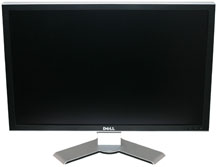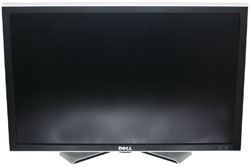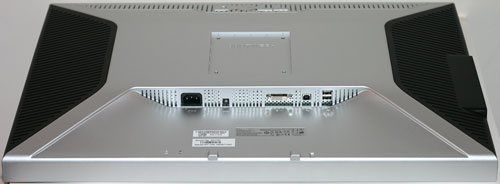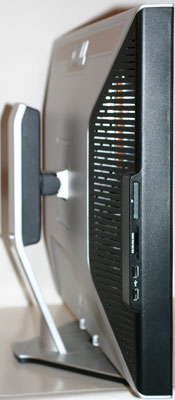Dell 2407WFP and 3007WFP LCD Comparison
by Jarred Walton on March 2, 2007 11:30 AM EST- Posted in
- Displays
Dell 3007WFP: Appearance and Design
The 3007WFP is almost a direct clone of the 2407WFP, at least in terms of the outward appearance. It's basically the big brother -- and we definitely mean BIG! Most users already think that a 24" LCD is pretty large, but the 2407WFP is absolutely dwarfed by the 3007WFP.
Other than the change in size, most of our commentary about the 2407WFP applies to the 3007WFP. It's attractive and it comes with a base stand that allows a reasonable amount of travel (about four inches).
You get tilt, swivel, and height adjustment courtesy of the base stand. If you prefer, you can also remove the base stand and use a standard 100mm VESA wall mount. Unlike the 2407WFP, there's no ability to rotate the display. Considering the size of the panel, that is to be expected -- you would need a base stand with about six inches of vertical travel to even be able to accommodate the increased height of portrait mode.
The rear of the display is relatively nondescript, but all of the connection ports are facing downwards so they aren't immediately visible.
As far as input ports go, as mentioned earlier only a single DVI port is present and the display requires a dual-link capable graphics card in order to run at its native 2560x1600 resolution. The 3007WFP can still function as a USB hub, and the USB input as well as two USB ports are located on the back of the display. Besides the main power connection, a power socket for an optional speaker bar is once again present.
Like the 2405FPW and 2407WFP, the left side provides two additional USB ports along with a flash memory reader. The same flash memory types as the 2407WFP are supported via the 9-in-2 reader.
Describing the On-Screen Display for the 3007WFP is extremely simple: there is no OSD! At the bottom of the display are three buttons: power, increase brightness, and decrease brightness. There are 20 levels of backlight intensity, but there's no immediate indication of your current setting. This is definitely taking minimalism to an extreme, and while many of the other features usually present in an OSD are unnecessary considering there is only one video input available, we really would have liked to see at least a few more options.
Speaking of options, we would also really like to see more video input choices. Granted, no analog signals are going to be capable of driving 2560x1600 resolution without experiencing signal degradation, but the 3007WFP does a good job at scaling non-native resolutions so it still should have been possible to include a VGA connection as well as component inputs and simply limit the maximum resolution with those connections to 1920x1200. We would also really like to be able to run single-link DVI at resolutions above 1280x800.
As it stands, the 3007WFP is intended pretty much only for use with a computer. Considering a 30" LCD is larger than a lot of people's televisions, it seems a shame to limit the versatility of the display.
30 Inch vs. 24 Inch
Having used both of these LCDs for a while, we felt it might be useful to provide our impressions of the experience. We used 21" CRTs for a long time, but the upgrade to a 24" LCD still broght noticeably more screen area. Personally, I held out switching to LCDs due to concerns about refresh rates and pixel response times, but when I finally upgraded to a 24" LCD (the 2405FPW), I was extremely pleased with the result. Some people still have complaints about LCDs versus CRTs, but overall we feel the benefits far outweigh the negatives and all of us are more than happy using LCDs on a daily basis.
If a 24" LCD feels pretty large compared to a 21" CRT (despite the fact that it weighs about one third as much), a 30" LCD is absolutely huge. Provided your eyesight is good enough, you almost feel the need to sit back several feet further away from the computer. Of course, the native resolution is such that icons and text are actually slightly smaller than what they would be on a 24" LCD, and if you end up sitting close to the screen like most people a 30" LCD can almost feel too big.
Another potential problem with such large LCDs is that they can require a ton of graphics power in order to run games at their native resolution. A single fast graphics card like a Radeon X1900 XT is generally sufficient for running most modern games at 1920x1200, but until the launch of the GeForce 8800 series it simply wasn't practical to play most games at 2560x1600 without dual GPUs. Even if you've got the graphics horsepower, configuring some games to run at the native resolution can be a pain, although thankfully this is getting better with time.
24" LCDs are pretty expensive still, and 30" LCDs are even more so, so before going out and spending a lot of money on a large LCD you will definitely want to try one out in person. Provided you have the hardware, using a 30" LCD is a really enjoyable experience for gaming and multitasking, at least from our perspective. Not everyone feels that way, however, and considering the price we feel that the 22"-26" LCDs are currently the sweet spot. You could purchase two 24" LCDs for the price of a 30" LCD right now, and there are also plenty of desks where it simply isn't practical to try and use a 30" display. If you've got the money and desk space, however, a 30" LCD definitely won't disappoint -- it just might take a little time to get used to having such a huge monitor.
The 3007WFP is almost a direct clone of the 2407WFP, at least in terms of the outward appearance. It's basically the big brother -- and we definitely mean BIG! Most users already think that a 24" LCD is pretty large, but the 2407WFP is absolutely dwarfed by the 3007WFP.
 |
| Click to enlarge |
Other than the change in size, most of our commentary about the 2407WFP applies to the 3007WFP. It's attractive and it comes with a base stand that allows a reasonable amount of travel (about four inches).
 |
 |
| Click to enlarge | |
You get tilt, swivel, and height adjustment courtesy of the base stand. If you prefer, you can also remove the base stand and use a standard 100mm VESA wall mount. Unlike the 2407WFP, there's no ability to rotate the display. Considering the size of the panel, that is to be expected -- you would need a base stand with about six inches of vertical travel to even be able to accommodate the increased height of portrait mode.
 |
| Click to enlarge |
The rear of the display is relatively nondescript, but all of the connection ports are facing downwards so they aren't immediately visible.
 |
| Click to enlarge |
As far as input ports go, as mentioned earlier only a single DVI port is present and the display requires a dual-link capable graphics card in order to run at its native 2560x1600 resolution. The 3007WFP can still function as a USB hub, and the USB input as well as two USB ports are located on the back of the display. Besides the main power connection, a power socket for an optional speaker bar is once again present.
 |
| Click to enlarge |
Like the 2405FPW and 2407WFP, the left side provides two additional USB ports along with a flash memory reader. The same flash memory types as the 2407WFP are supported via the 9-in-2 reader.
Describing the On-Screen Display for the 3007WFP is extremely simple: there is no OSD! At the bottom of the display are three buttons: power, increase brightness, and decrease brightness. There are 20 levels of backlight intensity, but there's no immediate indication of your current setting. This is definitely taking minimalism to an extreme, and while many of the other features usually present in an OSD are unnecessary considering there is only one video input available, we really would have liked to see at least a few more options.
Speaking of options, we would also really like to see more video input choices. Granted, no analog signals are going to be capable of driving 2560x1600 resolution without experiencing signal degradation, but the 3007WFP does a good job at scaling non-native resolutions so it still should have been possible to include a VGA connection as well as component inputs and simply limit the maximum resolution with those connections to 1920x1200. We would also really like to be able to run single-link DVI at resolutions above 1280x800.
As it stands, the 3007WFP is intended pretty much only for use with a computer. Considering a 30" LCD is larger than a lot of people's televisions, it seems a shame to limit the versatility of the display.
30 Inch vs. 24 Inch
Having used both of these LCDs for a while, we felt it might be useful to provide our impressions of the experience. We used 21" CRTs for a long time, but the upgrade to a 24" LCD still broght noticeably more screen area. Personally, I held out switching to LCDs due to concerns about refresh rates and pixel response times, but when I finally upgraded to a 24" LCD (the 2405FPW), I was extremely pleased with the result. Some people still have complaints about LCDs versus CRTs, but overall we feel the benefits far outweigh the negatives and all of us are more than happy using LCDs on a daily basis.
If a 24" LCD feels pretty large compared to a 21" CRT (despite the fact that it weighs about one third as much), a 30" LCD is absolutely huge. Provided your eyesight is good enough, you almost feel the need to sit back several feet further away from the computer. Of course, the native resolution is such that icons and text are actually slightly smaller than what they would be on a 24" LCD, and if you end up sitting close to the screen like most people a 30" LCD can almost feel too big.
Another potential problem with such large LCDs is that they can require a ton of graphics power in order to run games at their native resolution. A single fast graphics card like a Radeon X1900 XT is generally sufficient for running most modern games at 1920x1200, but until the launch of the GeForce 8800 series it simply wasn't practical to play most games at 2560x1600 without dual GPUs. Even if you've got the graphics horsepower, configuring some games to run at the native resolution can be a pain, although thankfully this is getting better with time.
24" LCDs are pretty expensive still, and 30" LCDs are even more so, so before going out and spending a lot of money on a large LCD you will definitely want to try one out in person. Provided you have the hardware, using a 30" LCD is a really enjoyable experience for gaming and multitasking, at least from our perspective. Not everyone feels that way, however, and considering the price we feel that the 22"-26" LCDs are currently the sweet spot. You could purchase two 24" LCDs for the price of a 30" LCD right now, and there are also plenty of desks where it simply isn't practical to try and use a 30" display. If you've got the money and desk space, however, a 30" LCD definitely won't disappoint -- it just might take a little time to get used to having such a huge monitor.










62 Comments
View All Comments
JarredWalton - Friday, March 2, 2007 - link
Noticing motion blur is one thing; being bothered by it will vary by individual. You mentioned Titan's Quest... I played that for over 100 hours without ever being bothered by motion blur. Are the item names clearly readable while running around? Not necessarily, but I can make them out well enough, and the names are secondary to the attributes, so I always ended up checking out items in my inventory.As for that video link... if my picture of a picture was a bad representation of what it's like using a display in person - and I feel it is, even with a decent SLR and a tripod - a handheld camcorder floating around recording a display is ten times worse. Are we supposed to be judging the quality of the display output or the quality of the camcorder and its ability to record LCD screen content? Or maybe the ability of the cameraman to give a reasonable representation of the LCD content? Because it seems to me that it's focused *much* more on the latter two than on the LCD itself. You can see the camera adjusting brightness/contrast on the fly depending on how much light its getting.
Basically, I agree that motion blur can bother people. It doesn't bother me... at all. What I see when playing games just blends together into relatively smooth gameplay, and a delay of a few hundredths of a second is short enough that my old and decrepit eyes don't care. That's why I repeatedly recommend people try out a display in person, because what you get via a review online or in a magazine is a poor substitute for hands on experience. As I state on page 5:
"Most of us don't have a problem with the slight image smearing that occurs on these LCDs, and the camera actually makes it look a lot worse than what we experience in person -- we may have simply captured two frames for all we know -- but this is something that will vary by individual. If you know you are bothered by image smearing, try out a display in person to see if it's suitable for your needs."
Zebo - Friday, March 2, 2007 - link
I have no idea how you guys can't see the color shifting in those PVA's. Every PVA I have tried has had it 1905, 2405 Gateway 24 & 21 etc Color Shifing so bad, viewing straight on, one eye can actualky see something different than the other eye (because the eyes are at different angles) it gave me a headache.Viewing angles on all PVA's suck thats just a fact that other people don't notice will never change my mind compared to an IPS or CRT it's night and day difference.
Heres a good shot of what I mean
http://img108.imageshack.us/img108/9021/dell2007wf...">http://img108.imageshack.us/img108/9021/dell2007wf...
JarredWalton - Friday, March 2, 2007 - link
PVA viewing angles are worse than some of the alternatives, but really how often do you *not* view the display head on? I seriously doubt that I'm ever more than 20 degrees away from a direct frontal view, and probable within 10 degrees in most cases. If that's not how you work with your PC, then other panels might be preferable. I've just never had any real concerns with viewing angles on the 24" LCDs I've tried. Laptop LCDs on the other hand... some of those are absolutely terrible, to the point where moving your head 6" can make the display almost illegible. That too is getting better, thankfully.Zebo - Saturday, March 3, 2007 - link
I view them straight on and they eyes see something different in each due to gamma/color shift. Look, even IPS isnt 178 degrees (or 90:P) like they advertise and starts to fade get shifty at around 35-45 degrees off center but PVA is literally about 5-10 - that's enough on a widescreen to be well over 5-10 degrees at the horizontal edges. Vertical color shift is evident raising my head only about 6" from about 20" away which is the difference between sitting up the chair vs. leaning back, a common position shift for a person using thier PC all day. Horizontal color shift is everywhere from 2-3 ft away. Every PVA panel has exhibited this problem and I know I'm sensitive to it as many don't notice but OTOH many do. TN lappy? don't get me started I just spent two miserable weeks in hotel with one.JarredWalton - Saturday, March 3, 2007 - link
My future laptop reviews are going to be running these sort of color tests and such as well. Of the few laptops I've tried so far, only the ASUS G2P was "good" in my opinion. Most others are a case of "I think I can live with it...." The problem is that unlike desktop LCDs, laptop LCDs frequently aren't bright enough. They focus more on conserving battery life, and while that might be good when they're unplugged, I'd just as soon forget about battery life when plugged in if it gives a better quality display result.timmiser - Friday, March 2, 2007 - link
The idea of getting 7 more inches for $400 less by going the route of a 37" HDTV 1080p is more appealing to me. That would be big screen gaming and spreadsheet work that would be awesome! I think it would be great if AT did a comparison between those two monitors just because they have such a different approach.I would like to see how the 37" 1920x1080 resolution looks compared to the Dell 3007 native resolution. One complaint I have is that the text gets smaller when the monitor gets bigger due to the extreme resolution for the Dell. The text should stay the same or get a little bigger when going to such a big screen in my opinion.
For an extra $100, I can get a 37" 1080p HDTV with a digital tuner which would be cool to switch to an HDTV broadcast on the fly.
Deusfaux - Friday, March 2, 2007 - link
I find it weird the 3007-HC (high color) isn't mentioned, as it's been announced and some people have been able to order it over the phone. It's the 3007 but with a little bit faster response time and better color reproduction (92% of the gamut vs 70-some% on the older 3007).JarredWalton - Friday, March 2, 2007 - link
When we can get one for comparison we'll see how it fares; right now Dell still seems to be shipping more of the "old" revision, and in testing we didn't have any complaints about the quality of the colors (once calibrated). We are trying to get other LCDs to compare with the current Dell offerings, though, so stay tuned....ViRGE - Friday, March 2, 2007 - link
Is Dell actually committed to keeping the 3007 an IPS panel? After the shenanigans that was the launch of the 2007, I'm afraid they'll jump ship to PVA/MVA as soon as they can, while all the reviews still reference the IPS panel.JarredWalton - Friday, March 2, 2007 - link
There are rumors that the new HC panel revision is going to switch to a different type of panel, but for now they're still IPS as far as we're aware. Hopefully they stay that way, but if they change and quality drops, we'll do our best to cover the situation.